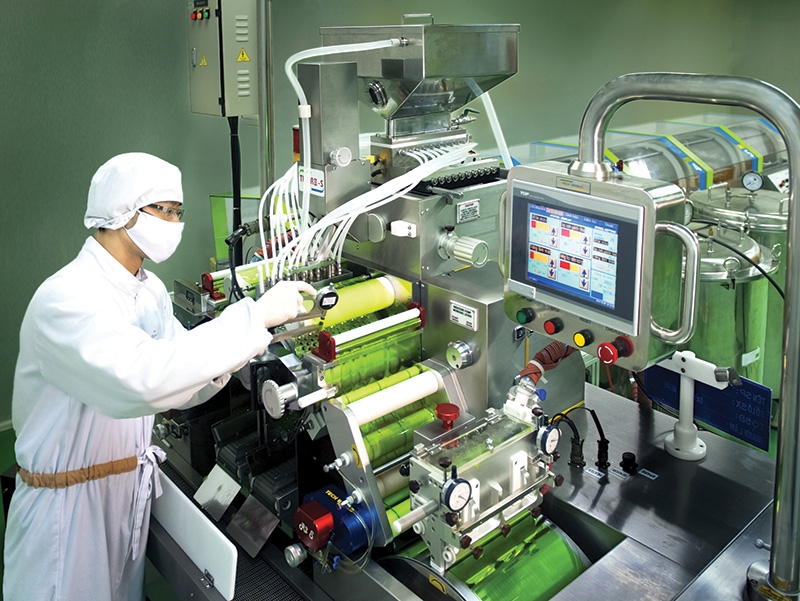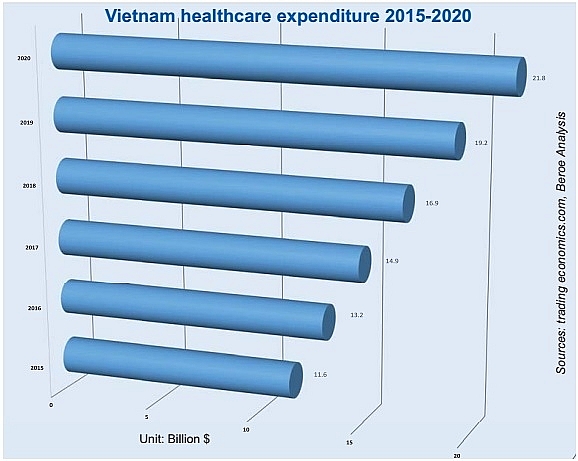Local pharma dives into ethical drugs
 |
| Domestic pharmaceutical companies are adapting to new technologies and expanding their networks to become more competitive, Photo: Le Toan |
Last week, Swiss-based Novartis announced that it had received a certificate of eligibility for the pharmacy business from the Ministry of Health (MoH) to directly import drugs to Vietnam, becoming the second such group after Sanofi.
With this development, Novartis is now able to become more involved in the country’s health programmes, aiming to increase access to medicines, especially to people in rural and remote areas.
The involvement of more multinational corporations (MNCs) – with GlaxoSmithKline and others said to be in the queue – is putting mounting pressure on local manufacturers, including drug giants such as Hau Giang Pharmaceutical JSC (DHG), Domesco Medical Import Export JSC, Imexpharm Pharmaceutical JSC (IMP), and Traphaco JSC, thus forcing them to take action in preparation for the ups and downs ahead.
 |
Bold solutions
Traphaco, the country’s second-largest publicly-traded drugmaker, is looking at developing the ethical drugs (ETC) channel, seeking partners and the production of franchised products, expanding its distribution network, diversifying products, and boosting sci-tech application in production.
“In preparation for mounting competition, we are completing procedures for a technology transfer project with South Korean partner Daewoong for its strategic products at a new factory located in the northern province of Hung Yen,” said Vu Thi Thuan, chairwoman of Traphaco.
“We now also have Mirae Asset as an indirect investor which helps us with opportunities to work with capable partners in technology transfer to shorten the research and development as well as the manufacturing of new high-quality products, thus enabling us to meet the requirements to join the ETC channel,” Thuan added.
Furthermore, Traphaco aims to work with foreign partners in the distribution of pharmaceuticals to hospitals, pharmacies, and retailers as local wholesalers to gain benefits from its strong distribution networks. At present, State Capital Investment Corporation, Magbi Fund Ltd., and Super Delta Pte., Ltd., are Traphaco’s biggest shareholders with stakes of 35.67, 24.99, and 15.12 per cent, respectively.
Similarly, IMP – the fourth-biggest drugmaker – is working to upgrade its plants to EU-GMP standards, thus allowing it to further venture into the ETC segment. IMP now has three plants, including one recently put into operation, and is now developing a further facility, with its opening scheduled for next year. IMP’s new factories focus on manufacturing western medicines meeting EU-GMP standards.
“With our new facilities, we aim to attain increased revenue from the ETC channel to make up 40 per cent of our total revenue in the future. We also aim to get 50 per cent from over-the-counter (OTC), non-prescription drugs, and the additional 10 per cent from exports,” said an IMP representative.
Meanwhile, DHG is also targeting the ETC segment and exports in its long-term development. In April, the firm announced two assembly lines meeting PIC/S-GMP and JAPAN-GMP standards, which are expected to help the group leapfrog its way into the ETC arena and in exports.
Boasting a wide network of 28,000 distribution agents at home, DHG is also expanding its export network to 14 global markets, including Singapore, Cambodia, Laos, Myanmar, Nigeria, and Indonesia.
Furthermore, DHG will boost technology transfer and co-operation with Japan’s Taisho in upgrading its beta-lactam factory to increase access to the ETC channel and exports to Russia and Moldova.
| Vietnam will host the Hospital Management Asia 2019 (HMA), one of the largest healthcare conferences of Asia, on September 11-12 in Hanoi. Hospital management and healthcare professionals from around the Asia Pacific region are expected to gather at the HMA to exchange ideas and insights on evolving business models, innovative technologies and improvements on the management of healthcare systems. As expected, Indonesian Hospital Association, Brawijaya Hospital Antasari, Apollo Hospital Group, GE Healthcare, Fortis Healthcare, Siemens Healthineers will be among the participants at the HMA. |
Bumps in the road ahead
In the domestic pharma market, the main distribution channel is ethical drugs, accounting for around 70 per cent, while the remainder of the market revolves around OTC and non-prescription drugs.
Overseas players hold the majority of the ETC channel due to ownership of brand-name drugs, which operate in a monopolistic manner and sell at high prices. Even for generic drugs, foreign pharma companies have more advantages than their local rivals, as their products are held in higher esteem than locally-made equivalents.
Industry insiders have said that when MNCs transfer technology of brand-name drug products to WHO-GMP factories in Vietnam, they eye tenders of Group 1 of brand-name drugs. Currently, MNCs are waiting for possible changes in drug rules that the MoH is working before unveiling its next move.
According to the latest draft, changes are proposed to be made towards the creation of several strict conditions for branded pharmaceutical production, possibly ensuring a tougher path for groups to attend drug tenders of high-priced brand-name drugs.
“This is an important issue affecting our company’s business strategy,” said an MNC representative. “There have been several meetings to discuss the possibilities of upgrading from WHO-GMP to EU-GMP. However, upgrading a factory in this way can take three to five years, excluding the time of inspection and licensing by authorised EU agencies.
With a stronger presence of MNCs with increasing volume of imports from Sanofi, Novartis, and others, as well as big plans to increase ETC stakes among local pharma counterparts, competition in this channel is expected to stiffen.
What the stars mean:
★ Poor ★ ★ Promising ★★★ Good ★★★★ Very good ★★★★★ Exceptional
Related Contents
Latest News
More News
- Human-centred governance seen as key to AI development (December 19, 2025 | 18:19)
- Top 10 notable events of Vietnam’s industry and trade sector in 2025 (December 19, 2025 | 14:00)
- Tungsten surges to 12-year high as world enters a new 'black gold' race (December 18, 2025 | 17:27)
- Vietnam’s coffee exports set new record despite price pressures (December 18, 2025 | 17:13)
- Garment and textile sector seeks new growth after volatile year (December 18, 2025 | 17:01)
- VinSpeed and Siemens strengthen cooperation for high-speed rail development (December 18, 2025 | 16:53)
- High-tech adoption for TH true MILK (December 18, 2025 | 13:39)
- Takeda supports health resilience amid climate change challenges (December 18, 2025 | 12:39)
- Mondelez Kinh Do - a chapter of purpose-led leadership in Vietnam (December 18, 2025 | 09:44)
- VNPAY services receive the highest-level PCI DSS international security certificates for six consecutive years (December 17, 2025 | 23:47)

 Tag:
Tag:





















 Mobile Version
Mobile Version